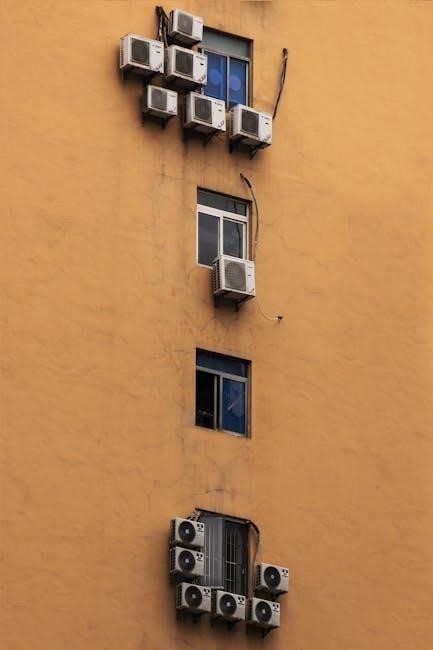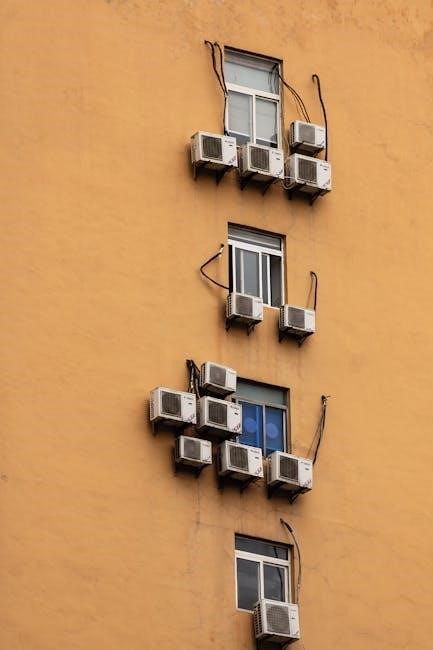air conditioner parts name pdf
Understanding air conditioner parts is essential for maintenance and repairs. A PDF guide provides detailed lists of components, such as compressors and condenser coils, ensuring efficiency and longevity.
Overview of Air Conditioner Components
An air conditioner consists of multiple essential components, each playing a vital role in cooling and maintaining air quality. The indoor unit includes parts like the evaporator coil, blower fan, and air filter, while the outdoor unit houses the compressor, condenser coil, and outdoor fan. These components work together to transfer heat and regulate temperature. A PDF guide provides a detailed list of these parts, including descriptions, part numbers, and quantities, making it easier to identify and replace them when necessary. Understanding these components is crucial for proper maintenance and ensuring optimal performance. The guide also includes pricing information, helping users budget for repairs or upgrades. This comprehensive overview ensures users can navigate AC systems with confidence.

Importance of Understanding AC Parts
Understanding air conditioner parts is crucial for effective maintenance, troubleshooting, and repairs. Knowing each component’s function, such as the compressor and condenser coil, helps identify issues early, preventing costly breakdowns. A PDF guide provides detailed lists of parts, including descriptions and numbers, enabling users to locate and replace components efficiently. This knowledge also aids in optimizing energy efficiency and extending the system’s lifespan. By familiarizing oneself with AC parts, users can perform routine maintenance, such as cleaning the air filter or inspecting the evaporator coil, ensuring the system runs smoothly. This understanding empowers homeowners and technicians to make informed decisions, reducing reliance on external services and enhancing overall system performance.

Key Components of an Air Conditioner
An air conditioner consists of essential parts like the compressor, condenser coil, evaporator coil, thermostat, and blower fan, all crucial for cooling and airflow efficiency.

Compressor
The compressor is the heart of an air conditioner, responsible for compressing refrigerant to facilitate heat transfer. Located in the outdoor unit, it converts refrigerant from gas to liquid, enabling cooling. A key component in the refrigeration cycle, the compressor consumes significant power and requires regular maintenance to ensure efficiency. Proper functioning ensures optimal cooling performance. Detailed in the air conditioner parts name PDF, it is listed with specific part numbers and descriptions for easy identification and replacement. Regular checks and maintenance are crucial to extend its lifespan and prevent system failures. Understanding its operation and importance helps in troubleshooting common AC issues effectively.
Condenser Coil
The condenser coil is a critical component located in the outdoor unit of an air conditioner. Its primary function is to dissipate heat from the hot refrigerant gas to the surrounding air, converting it into a liquid. This process is essential for the cooling cycle. The coil is typically made of copper or aluminum for efficient heat transfer. Regular cleaning is necessary to remove dirt and debris, which can reduce efficiency and increase energy consumption. The air conditioner parts name PDF provides detailed specifications, part numbers, and descriptions for the condenser coil, making it easier to identify and replace when necessary. Proper maintenance ensures optimal performance and extends the lifespan of the entire system.

Evaporator Coil
The evaporator coil is a key component located in the indoor unit of an air conditioner. Its primary role is to absorb heat from the surrounding air, cooling it down and transferring the heat to the refrigerant. This process allows the refrigerant to evaporate into a gas, which is then cooled by the condenser coil. The evaporator coil is typically made of copper or aluminum for efficient heat transfer. Regular cleaning is essential to prevent dust buildup, which can reduce airflow and system efficiency. The air conditioner parts name PDF provides detailed information, including part numbers and descriptions, to help identify and maintain the evaporator coil effectively. Proper maintenance ensures consistent cooling performance and prevents potential system damage.
Thermostat
The thermostat is a crucial component that monitors and regulates the temperature in a space. It acts as the brain of the air conditioning system, turning the unit on or off to maintain the desired temperature. Modern thermostats are programmable, allowing users to set schedules for energy efficiency. The air conditioner parts name PDF includes detailed information about the thermostat, such as its part number, description, and location within the system. Proper installation and calibration are essential for accurate temperature control. The thermostat also ensures that other components, like the compressor and blower fan, operate efficiently. Regular checks and maintenance, as outlined in the PDF guide, help prevent malfunctions and extend the system’s lifespan. Understanding the thermostat’s role is vital for optimizing cooling performance and energy savings.
Blower Fan

The blower fan is a key component responsible for circulating air through the air conditioning system. It ensures that cooled or heated air is distributed evenly throughout the space. Located in the indoor unit, the blower fan works in conjunction with the evaporator coil to enhance heat transfer and improve system efficiency. The air conditioner parts name PDF provides detailed specifications, including part numbers and descriptions, to help identify and replace the blower fan if necessary. Regular maintenance, such as cleaning the fan blades and ensuring proper alignment, is crucial for optimal performance. A malfunctioning blower fan can lead to reduced airflow and increased energy consumption, making it essential to monitor its condition and address issues promptly. Proper functioning of the blower fan is vital for maintaining consistent indoor air quality and comfort.
Air Filter
The air filter is a crucial component in an air conditioning system, designed to remove dust, allergens, and other particles from the air. Located in the indoor unit, it ensures clean air circulation and protects internal components from dust buildup. The air conditioner parts name PDF includes detailed specifications for the air filter, such as part numbers and sizes, to facilitate easy identification and replacement. Regular maintenance, including cleaning or replacing the filter, is essential for optimal performance. A dirty or clogged air filter can reduce airflow, lower efficiency, and increase energy consumption. Properly maintaining the air filter not only improves indoor air quality but also extends the lifespan of the system. Referencing the PDF guide helps ensure the correct replacement part is used, maintaining the system’s efficiency and effectiveness.
Outdoor Fan

The outdoor fan plays a vital role in air conditioning systems by circulating air through the condenser coil. It ensures efficient heat dissipation, which is essential for the system’s cooling process. The air conditioner parts name PDF provides detailed information about the outdoor fan, including its part number, specifications, and maintenance requirements. Proper functioning of the outdoor fan is crucial to prevent overheating and maintain optimal performance. Regular inspection and cleaning of the fan blades and motor are recommended to ensure smooth operation. If the fan fails, it can lead to reduced cooling efficiency and potential damage to other components. The PDF guide helps users identify and replace the outdoor fan if necessary, ensuring the system runs efficiently and effectively. Always refer to the guide for accurate part numbers and installation instructions.
Refrigerant

The refrigerant is a critical substance in air conditioning systems, enabling heat transfer between the indoor and outdoor units. The air conditioner parts name PDF details the type and amount of refrigerant required, ensuring proper system operation. It also outlines safety precautions and handling guidelines, as refrigerants can be hazardous if mishandled. The PDF guide specifies part numbers for refrigerant recharge kits and compatible types, such as R-32 or R-410A. Regular inspection of refrigerant levels is essential to maintain efficiency and prevent leaks. If refrigerant levels drop, the system may fail to cool effectively. Always refer to the PDF guide for accurate information on refrigerant specifications and replacement procedures to ensure safe and efficient system performance. Proper refrigerant management is vital for the longevity and functionality of the air conditioner.
Expansion Valve
The expansion valve is a crucial component in air conditioning systems, regulating the flow of refrigerant into the evaporator coil. The air conditioner parts name PDF provides detailed specifications, including part numbers and descriptions, to ensure accurate identification and replacement. This valve reduces refrigerant pressure, allowing it to expand and cool before entering the evaporator. Proper functioning of the expansion valve is essential for efficient cooling and system performance. The PDF guide also outlines troubleshooting tips for common issues, such as refrigerant leaks or improper cooling, which can often be traced back to the expansion valve. Regular maintenance, as specified in the guide, helps prevent malfunctions and ensures optimal system operation. Referencing the PDF ensures technicians and users can identify and address expansion valve issues effectively, maintaining the air conditioner’s efficiency and longevity.
Capacitor
The capacitor plays a vital role in an air conditioner’s operation by storing electrical energy to power the compressor, fan motors, and other components. The air conditioner parts name PDF provides detailed specifications, including part numbers and descriptions, to ensure accurate identification and replacement. Capacitors are essential for starting and running motors smoothly, and their failure can lead to system malfunctions. The PDF guide outlines key characteristics, such as voltage ratings and capacitance values, to help technicians and users select the correct replacement. Regular inspection and testing of the capacitor, as recommended in the guide, can prevent unexpected breakdowns. Proper installation and maintenance of the capacitor are crucial for ensuring the air conditioner operates efficiently and reliably. Referencing the PDF ensures accurate troubleshooting and replacement, extending the system’s lifespan.
Relay
The relay is a critical electrical component in an air conditioner that acts as a switch to control the flow of power to various parts, such as the compressor and fan motors. It ensures that these components operate only when needed, preventing unnecessary energy consumption. The air conditioner parts name PDF provides detailed information about the relay, including its part number, description, and voltage compatibility. This guide helps technicians and users identify the correct relay for replacement, ensuring proper system functionality. The relay is essential for protecting the AC from power surges and electrical faults. Regular inspection of the relay, as outlined in the PDF, can prevent system malfunctions. Proper installation and maintenance of the relay are vital for ensuring the air conditioner runs efficiently and reliably. The PDF guide serves as a valuable resource for troubleshooting and replacing the relay effectively.
Contactors
Contactors are electrical switches in an air conditioner that control the flow of power to major components like the compressor and condenser fan. They ensure these parts start and stop safely. The air conditioner parts name PDF lists contactors with their part numbers, descriptions, and specifications, aiding in identification and replacement. Contactors are crucial for protecting the system from electrical surges and overloads. Regular inspection, as per the PDF guide, helps prevent malfunctions. Proper installation and maintenance of contactors are essential for efficient AC operation. The PDF serves as a key resource for technicians and users to troubleshoot and replace contactors effectively, ensuring reliable system performance. This component is vital for maintaining the overall functionality and longevity of the air conditioning system.
Drain Pan
The drain pan is a crucial component of an air conditioner, designed to collect condensate water from the evaporator coil. It ensures proper drainage, preventing water damage or mold growth. The air conditioner parts name PDF includes the drain pan as a key component, detailing its part number, description, and specifications. Regular inspection and cleaning of the drain pan are essential to maintain system efficiency and prevent clogs. If neglected, water overflow can lead to system damage or indoor flooding. The PDF guide provides clear instructions for identifying and replacing the drain pan if it becomes corroded or damaged; Proper maintenance of this component is vital for ensuring the air conditioner operates smoothly and safely. The drain pan plays a significant role in protecting both the system and the surrounding area from water-related issues.
Ductwork
Ductwork refers to the network of ducts that distribute cooled or heated air throughout a building. It is a critical component of an air conditioning system, ensuring efficient airflow. The air conditioner parts name PDF includes detailed specifications for ductwork materials, such as galvanized steel or insulated flexible ducts. Proper sizing and installation of ductwork are essential to maintain system performance and energy efficiency. The PDF guide also provides diagrams and part numbers for ductwork components, making it easier to identify and replace damaged sections. Regular cleaning and inspection of ductwork are recommended to prevent dust buildup and leaks, which can reduce system efficiency. Ensuring tight connections and proper sealing is vital to maintain optimal airflow and prevent energy loss. The ductwork system plays a key role in delivering conditioned air evenly across all spaces.
Vents
Vents are essential components of an air conditioning system, serving as the points where conditioned air is released into a room. They are typically installed in walls, floors, or ceilings. The air conditioner parts name PDF provides detailed information about vent types, including supply vents and return vents. Supply vents distribute cooled or heated air, while return vents pull stale air back into the system. The PDF guide lists vent sizes, materials, and part numbers, making it easier to identify and replace them. Proper installation and maintenance of vents are crucial to ensure even airflow and system efficiency. Cleaning vents regularly can prevent dust buildup and improve air quality. The PDF also offers diagrams to help locate and install vents correctly, ensuring optimal performance of the air conditioning system.
Remote Control
The remote control is a convenient accessory for operating air conditioners, allowing users to adjust settings like temperature, fan speed, and modes. The air conditioner parts name PDF includes details about remote control components, such as batteries, LCD screens, and buttons. It also lists part numbers for remotes, ensuring easy identification and replacement. The PDF guide explains how to program timers and set preferences, enhancing user comfort. Proper maintenance, like cleaning buttons and replacing batteries, is also covered. The remote control plays a vital role in optimizing AC performance and energy efficiency. By referencing the PDF, users can troubleshoot issues or order spare parts directly, ensuring seamless operation of their air conditioning system. This section highlights the importance of the remote control in modern AC systems.
Sensors
Sensors in air conditioners play a crucial role in maintaining optimal performance and efficiency. The air conditioner parts name PDF details various sensors, such as temperature, humidity, and pressure sensors, which monitor environmental conditions. These sensors ensure the AC adjusts settings accurately, providing consistent comfort. The PDF guide lists part numbers and descriptions for sensors, aiding in identification and replacement. Regular maintenance, like cleaning or recalibrating sensors, is essential to prevent malfunctions. Faulty sensors can lead to inefficient operation, so the guide emphasizes their importance. By understanding sensor functions, users can troubleshoot issues and ensure their AC runs smoothly. This section highlights how sensors contribute to overall system efficiency and user satisfaction. Proper care and replacement of sensors are vital for long-term performance.
Air Conditioner Parts Name PDF Guide
The Air Conditioner Parts Name PDF Guide provides a comprehensive list of components, including part numbers, descriptions, and prices, aiding in easy identification and replacement of AC parts.
Structure of the PDF Document
The PDF guide is organized into clear sections, starting with an introduction to the air conditioner model. It lists 30 indoor and 30 outdoor unit parts, each detailed with numbers, descriptions, and prices. The document includes diagrams for visual identification and a spare parts list with part numbers, quantities, and costs in USD. Additional sections cover technical specifications and maintenance tips, ensuring a comprehensive resource for users. This structured format makes it easy to locate and understand specific components, aiding in efficient repairs and replacements.

How to Read the Spare Parts List
The spare parts list in the PDF is structured for easy navigation; Each component is listed with a part number, description, quantity, and price. Users can identify parts by their assigned numbers, which correspond to diagrams. Descriptions provide clarity on the function and location of each part. Quantities indicate how many of each item are required, while prices are listed in USD for budgeting. The document also includes visual aids like diagrams to help users locate parts. For example, the compressor and condenser coil are highlighted with specific details. By referencing these sections, users can efficiently identify and order necessary components for repairs or replacements.
Understanding Part Numbers and Descriptions
Part numbers and descriptions in the PDF guide are crucial for identifying components. Each part is assigned a unique number and a detailed description to ensure accuracy. For example, the compressor might be listed as “COMP-1234” with a description like “Outdoor Unit Compressor.” These codes help users and technicians quickly locate and order the correct parts. Descriptions often include the component’s function and location, such as “Indoor Unit Evaporator Coil.” This system prevents confusion and ensures the right parts are used for repairs. By referencing these codes, users can efficiently maintain or replace components, ensuring their air conditioner operates efficiently. This structured approach simplifies the process of identifying and procuring spare parts.

Maintenance and Replacement Tips
Regular maintenance ensures efficiency. Check and clean the air filter monthly; Clean the evaporator and condenser coils regularly. Inspect the drain pan for leaks. Replace damaged or worn parts promptly.
Regular Maintenance of AC Parts
Regular maintenance is crucial for optimal performance. Clean the air filter monthly to ensure proper airflow. Inspect and clean the evaporator coil and condenser coil regularly to prevent dust buildup. Check the drain pan for leaks and ensure it’s draining properly. Verify the thermostat accuracy to maintain desired temperatures. Inspect the capacitor and relay for wear or damage. Clean the outdoor fan and ensure it’s functioning correctly. Replace worn-out parts promptly to avoid system failure. Refer to the PDF guide for specific maintenance schedules and part details. Proper upkeep extends the lifespan of your air conditioner and ensures efficient operation.
When to Replace Air Conditioner Components
Replace compressor if it fails or leaks refrigerant. Swap condenser or evaporator coils if corroded or blocked. Replace thermostat if temperature control falters. Change blower fan if worn or noisy. Replace air filter every 1-3 months. Swap outdoor fan if damaged. Recharge or replace parts if refrigerant leaks. Replace expansion valve if faulty. Swap capacitor or relay if worn. Replace contactors if malfunctioning. Replace drain pan if leaking. Fix or replace ductwork if leaking. Clean or replace vents if blocked. Replace remote control if unresponsive. Replace sensors if inaccurate. Timely replacements ensure efficiency and prevent system failure, as outlined in the PDF guide.
